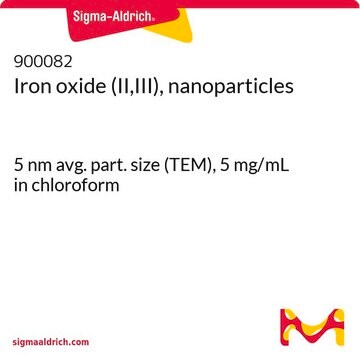725331
Iron oxide(II,III), magnetic nanoparticles solution
5 nm avg. part. size, 5 mg/mL in H2O
Sinonimo/i:
Magnetic iron oxide nanocrystals, Magnetite, Superparamagnetic iron oxide nanoparticles
About This Item
Prodotti consigliati
Forma fisica
dispersion
nanoparticles
Livello qualitativo
Concentrazione
5 mg/mL in H2O
Magnetizzazione
>25 emu/g, at 4500Oe
Dimensione particelle
4-6 nm (TEM)
Dimens. media delle particelle
5 nm
Densità
1.00 g/mL at 25 °C
Stringa SMILE
O=[Fe].O=[Fe]O[Fe]=O
InChI
1S/3Fe.4O
SZVJSHCCFOBDDC-UHFFFAOYSA-N
Cerchi prodotti simili? Visita Guida al confronto tra prodotti
Descrizione generale
Applicazioni
Codice della classe di stoccaggio
12 - Non Combustible Liquids
Classe di pericolosità dell'acqua (WGK)
nwg
Punto d’infiammabilità (°F)
Not applicable
Punto d’infiammabilità (°C)
Not applicable
Scegli una delle versioni più recenti:
Possiedi già questo prodotto?
I documenti relativi ai prodotti acquistati recentemente sono disponibili nell’Archivio dei documenti.
I clienti hanno visto anche
Articoli
A key challenge for nanomaterial safety assessment is the ability to handle the large number of newly engineered nanomaterials (ENMs), including developing cost-effective methods that can be used for hazard screening.
Professor Hui Mao explores the use of superparamagnetic iron oxide nanoparticles (INOPs) that offer an alternate contrast-enhancing mechanism.
Professor Yadong Yin (University of California Riverside, USA) examines both direct (thermal decomposition, solvothermal, hydrothermal) and indirect (templated) synthesis methods of magnetite nanocrystals and reviews in detail the landscape of these various synthetic methods for magnetite nanocrystal and their applications in magnetic assembly, magnetic hyperthermia, and Li-Ion batteries.
The application of magnetism and magnetic materials pervades our modern civilization in the form of electrical power, communications and information storage.
Il team dei nostri ricercatori vanta grande esperienza in tutte le aree della ricerca quali Life Science, scienza dei materiali, sintesi chimica, cromatografia, discipline analitiche, ecc..
Contatta l'Assistenza Tecnica.

